"Dear Dr. Bowser, Thank you. I liked the dynamite. From, Bryan” This young student's thank you note to Dr. Sam Bowser (who studies Antarctic foraminifera) is on the outhouse wall at New Harbor camp. We could have used some dynamite today!
We started with a big breakfast and got out to the far dive site named "Deep” this morning. Stacy, Nick and Marcus started drilling the ten-inch hole for SCINI to dive through. Drilling this large of a diameter hole is enormously challenging and the ice was over 16 feet thick. Notice Nick on the drill box to put more pressure on the drill going through the ice.
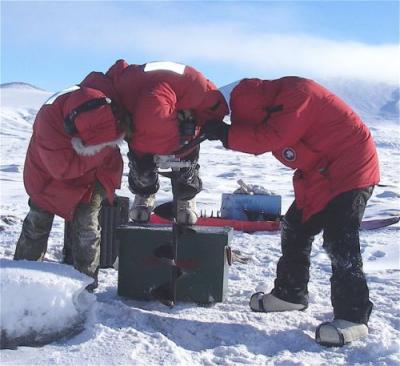
Marcus, Nick and Stacy pushing on the Jiffy Drill head to cut through the ice
When they broke through the ice at the bottom, the water pressure shot the drill out of the hole and over their heads! They got the drill back in the hole and cleaned out the new hole by plunging the flights up and down to draw up the slush. Then they removed the drill head and started pulling up the flights. You can see how deep the ice is by how long the series of flights is.
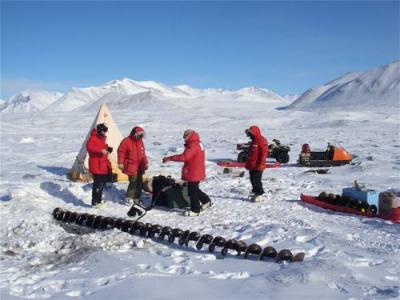
The flights by the newly drilled hole
Bob, Bryan and I had set up the Scott Tent (in background above) and then put in a kerosene heater to keep the computers warm and moved in a table, SCINI (in the box Bryan is sitting on) and the computers to operate SCINI.
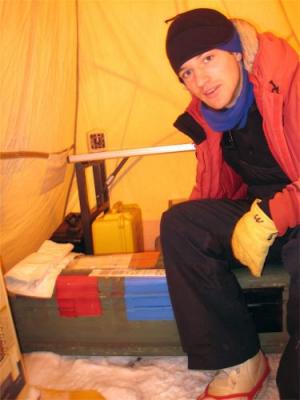
Bryan in the Scott Tent
Once the large hole for SCINI was drilled, we needed to drill two more holes for the transducers to be lowered on cables through the sea ice so SCINI can have triangular navigation control.
We were on the second 5-inch hole when the sixth flight broke through the sea ice and plunged down and got the drill stuck. It seems like it should be "easy” to get it out through a hole that is already drilled, but the slush in the hole immediately freezes around the metal flights and the whole darn thing is stuck.
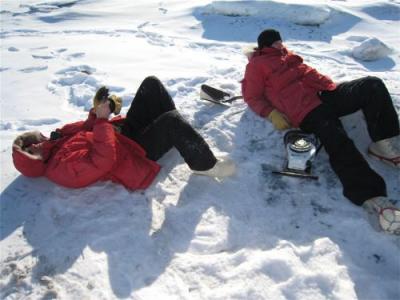
Bob and Bryan thinking through how to best get the flights out
Bryan chipped around the drill head so Bob could unscrew it from the flights. Then we tried a large torque bar to unwind the flights out, but only got a short ways out. The next step was to bring over the hotsie to thaw it out.
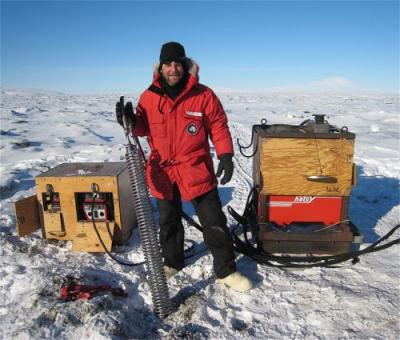
Marcus with the generator, the hot finger and the hotsie.
Remember from yesterday’s journal that both the hot finger and the hotsie had problems? Well, today we got another helicopter drop of a new hotsie and hotfinger and they picked up the problem ones. Phew! Think again (and again) of how many people, how much equipment, and how much fuel is used for science to occur on this continent.
Meanwhile Bob and Nick lowered SCINI into the 10-inch hole and we ran transducers in both SCINI’s hole and the one successful 5-inch hole. We had to keep them free of ice by lowering a soup ladle and taking the slush out every 20 minutes so the holes didn’t freeze.
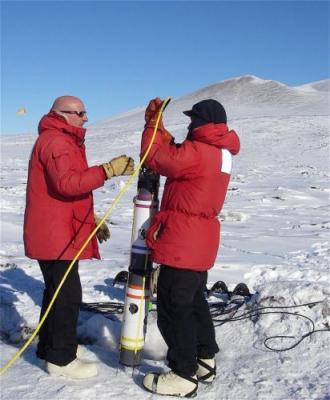
Bob and Nick lowering SCINI into the 10-inch hole
Even though the navigation couldn’t be completed without a third hole, Bryan and Nick did the best they could. Stacy observed SCINI to make sure it wasn’t touching the bottom or bumping into any structures or organisms like sponges and crinoids that can rise up off the seafloor. There are data from 40 years ago that could potentially be ruined if SCINI knocked into it!

Bryan and Nick navigating SCINI the best they can
We went to bed exhausted after creating teams to go out and check the hotsie position in the sea ice and refuel both the generator and the hotsie at 3-hour intervals. Marcus and I were the 4:30 a.m. team and it was another beautiful, sunny day with – 15 F temperatures when we headed out! But we’ll save that for tomorrow’s journal!

